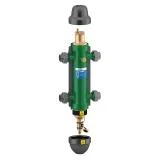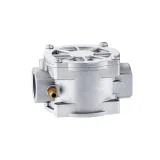

The central heating system essentially consists of:
- Condensing boilers fitted with built-in pumps and outside compensated temperature regulation, which are capable of running even when the flow rate is zero and at low temperature
- Multi-function hydraulic separator with deaerator and magnetic dirt separator
- High efficiency tandem circulation pump
- Control, expansion and safety equipment
- System charging unit with pressure reducing valve and backflow preventer
This solution is generally used in the following cases:
- New systems with heat interface units, i.e. with zone outlets able to provide both heating and domestic hot water production;
- Refurbished legacy systems with thermostatic valves on the individual radiators.
In fact, with this type of system the considered solution makes it possible to operate with the minimum possible flow rates in circulation (thereby offering savings in terms of pump management) and with low return temperatures (greater efficiency of condensing boilers).
The water temperature at the outlet to the radiators can be regulated:
- In the case of systems with heat interface units, with outside compensated temperature curve and minimum temperature limit of between 60 and 65 °C
- In the case of refurbished legacy systems with thermostatic regulator valves, simply with the outside compensated temperature curve.
In this compact version, the deaerator and dirt separator are built into the hydraulic separator.
The deaerator (inside the separator) serves to eliminate air pockets and micro-bubbles from the system water. This means it helps to reduce phenomena of corrosion and noise of the thermostatic valves.
The dirt separator (inside the separator) intercepts and removes dirt particles normally suspended in the water of heating systems. In particular, the version with magnet is designed to intercept particles of magnetite, thus preventing them from collecting (and causing serious damage as a result) on the magnetic rotors of new high-efficiency pumps.
If necessary, or if required by current legislation relating to water hardness, the heating system water must be suitably treated.
Note:
The control, expansion and safety equipment must be of appropriate size to reflect the heating capacity and specific characteristics of the system, in accordance with applicable laws and regulations.






